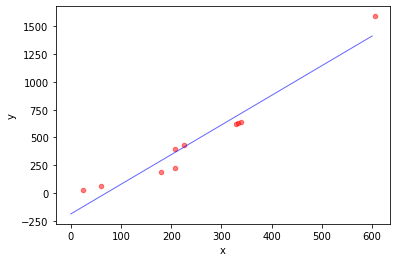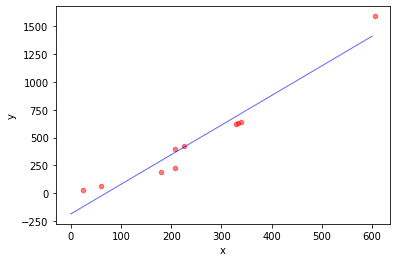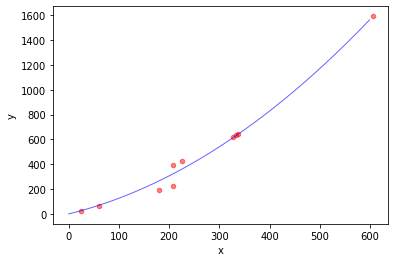线性回归 线性模型 :
数据集:$D = \{(\boldsymbol{x}_1, y_1), (\boldsymbol{x}_2, y_2), … , (\boldsymbol{x}_m, y_m)\}$,$\boldsymbol{x}_i = (x_{i1}; x_{i2};…; x_{id})$
损失函数 (Loss function) 采用平方损失:
目标是找到一组解 $(\boldsymbol{w}^{\star}, b^{\star})$ 使得损失函数的值最小,即:
求解方法:
损失函数的代码实现:
1 2 3 4 5 import numpy as npimport matplotlib.pyplot as pltimport pandas as pdimport mathimport random
1 2 3 4 5 6 7 8 9 10 11 12 13 14 15 16 17 18 19 20 21 22 23 24 25 26 27 28 29 30 31 32 33 34 35 36 37 38 39 40 41 42 43 def loss_function (w, b, x, y) : x = np.array(x) y = np.array(y).reshape(len(y), 1 ) w = np.array(w) b = np.array(b) x = np.matrix(x) y = np.matrix(y) w = np.matrix(w) b = np.matrix(b) err = [[0.0 ]] m = len(x) for i in range(m): err = err + (y[i] - w.T * x[i] - b) ** 2 return err.tolist()[0 ][0 ] def loss_function (w, x, y) : x = np.array(x) y = np.array(y).reshape(len(y), 1 ) w = np.array(w) x=np.concatenate((x, np.ones((len(x), 1 ))), axis=1 ) x = np.matrix(x) y = np.matrix(y) w = np.matrix(w) err = 0.0 m = len(x) for i in range(m): pp= x[i] * w p=(y[i] - pp.T ) err = err + p * p.T return err.tolist()[0 ][0 ]
1 2 3 4 5 6 x = [ [1. ], [2. ]] y = [ 1. , 2. ] print(loss_function([1 ], 0 , x, y))
运行结果为:
0.0
最小二乘法 把 $\boldsymbol{w}$ 和 $b$ 吸收入向量形式 $\hat{\boldsymbol{w}} = (\boldsymbol{w}; b)$
把数据集 $D$ 的输入表示为一个 $m \times (d + 1)$ 大小的矩阵 $\boldsymbol{X}$
把输出也表示成向量形式 $\boldsymbol{y} = (y_1; y_2; …; y_n)$
式(2) 可表示为
式(3) 可表示为
对式(4)求导可得
当 $\boldsymbol{X}^T\boldsymbol{X}$ 为满秩矩阵时(不是满秩矩阵时无法求解),令式(5)等于0可得解为
Python代码实现:
1 2 import numpy as npfrom numpy import *
1 2 3 4 5 6 7 8 9 10 11 12 13 14 15 16 17 18 19 20 def get_w (x, y) : w = (x.T * x).I * x.T * y return w.tolist() def least_squares (x, y) : x = np.array(x) x = np.concatenate((x, np.ones((len(x), 1 ))), axis=1 ) x = np.matrix(x) y = np.array(y).reshape(len(y), 1 ) y = np.matrix(y) return get_w(x, y)
1 2 3 4 5 6 7 8 9 10 11 x = [ [338. ], [333. ], [328. ], [207. ], [226. ], [25. ], [179. ], [60. ], [208. ], [606. ]] y = [ 640. , 633. , 619. , 393. , 428. , 27. , 193. , 66. , 226. , 1591. ] w = least_squares(x, y) w0 = w[0 :len(w) - 1 ][0 ] print(math.sqrt(loss_function(w0, w[-1 ][0 ], x, y)) / len(x))
运行结果为:
31.927531989787543
1 2 3 4 5 6 7 8 9 10 11 12 13 14 15 16 17 18 19 20 21 22 23 24 25 26 27 28 29 30 31 32 x_list = [] y_list = y for i in x: x_list.append(i[0 ]) ax = plt.gca() ax.set_xlabel('x' ) ax.set_ylabel('y' ) ax.scatter(x_list, y_list, c='r' , s=20 , alpha=0.5 ) print(str(w[0 ][0 ]) + ' ' + str(w[1 ][0 ])) p1 = [0 , 600 ] p2 = [0 * w[0 ][0 ] + w[1 ][0 ], 600 * w[0 ][0 ] + w[1 ][0 ]] ax1 = plt.gca() ax1.set_xlabel('x' ) ax1.set_ylabel('y' ) ax1.plot(p1, p2, color='b' , linewidth=1 , alpha=0.6 ) plt.show()
模型的解为:
2.669454966762257 -188.43319665732653
采用statsmodels库求线性回归作为对比:
1 2 3 4 5 6 7 8 9 import statsmodels.api as smimport matplotlib.pyplot as pltx = [ [338. ], [333. ], [328. ], [207. ], [226. ], [25. ], [179. ], [60. ], [208. ], [606. ]] y = [ 640. , 633. , 619. , 393. , 428. , 27. , 193. , 66. , 226. , 1591. ] x = sm.add_constant(x) model = sm.OLS(y, x).fit() print(model.summary())
OLS Regression Results
==============================================================================
Dep. Variable: y R-squared: 0.944
Model: OLS Adj. R-squared: 0.938
Method: Least Squares F-statistic: 136.1
Date: Wed, 10 Jun 2020 Prob (F-statistic): 2.66e-06
Time: 07:28:51 Log-Likelihood: -60.337
No. Observations: 10 AIC: 124.7
Df Residuals: 8 BIC: 125.3
Df Model: 1
Covariance Type: nonrobust
==============================================================================
coef std err t P>|t| [0.025 0.975]
------------------------------------------------------------------------------
const -188.4332 67.619 -2.787 0.024 -344.363 -32.503
x1 2.6695 0.229 11.667 0.000 2.142 3.197
==============================================================================
Omnibus: 1.562 Durbin-Watson: 2.661
Prob(Omnibus): 0.458 Jarque-Bera (JB): 0.877
Skew: 0.356 Prob(JB): 0.645
Kurtosis: 1.737 Cond. No. 560.
==============================================================================
Warnings:
[1] Standard Errors assume that the covariance matrix of the errors is correctly specified.
/usr/local/lib/python3.6/dist-packages/scipy/stats/stats.py:1535: UserWarning: kurtosistest only valid for n>=20 ... continuing anyway, n=10
"anyway, n=%i" % int(n))
可以看到结果基本一致。
梯度下降法 式(4)的梯度为
根据梯度下降法,不断更新 $\hat{\boldsymbol{w}}$ 去寻找 $\hat{\boldsymbol{w}}^*$。参数的更新以目标的负梯度为方向,$t$ 表示第 $t$ 次更新参数,$\eta$ 表示学习率。
Python代码实现:
1 2 3 import numpy as npimport matplotlib.pyplot as pltimport pandas as pd
1 2 3 4 5 6 7 8 9 10 11 12 13 14 15 16 17 18 19 20 21 22 23 24 25 26 27 28 29 def gradient (w, x, y) : x = np.array(x) y = np.array(y).reshape(len(y), 1 ) x = np.concatenate((x, np.ones((len(x), 1 ))), axis=1 ) w = np.array(w) x = np.matrix(x) y = np.matrix(y) w = np.matrix(w) return 2 * x.T * (x * w - y) def gradient_descent (x, y) : lr = 0.0000001 iteration = 1000000 w = np.ones((1 , len(x[0 ]) + 1 )).T w[len(x[0 ])][0 ] = y[0 ] - x[0 ][0 ] for i in range(iteration): w = w - lr * gradient(w, x, y) return w
测试结果:
1 2 3 4 5 6 7 8 9 10 11 12 13 14 15 16 17 18 19 20 x = [ [338. ], [333. ], [328. ], [207. ], [226. ], [25. ], [179. ], [60. ], [208. ], [606. ]] y = [ 640. , 633. , 619. , 393. , 428. , 27. , 193. , 66. , 226. , 1591. ] w = gradient_descent(x, y) w = w.tolist() print(w) w0 = w[0 :len(w) - 1 ][0 ] print(math.sqrt(loss_function(w, x, y)) / len(x))
模型的解及误差为:
[[2.664103150270952], [-186.57092397847248]]
31.929045483933738
1 2 3 4 5 6 7 8 9 10 11 12 13 14 15 16 17 18 19 20 21 22 23 24 25 26 27 28 29 30 31 32 x_list = [] y_list = y for i in x: x_list.append(i[0 ]) ax = plt.gca() ax.set_xlabel('x' ) ax.set_ylabel('y' ) ax.scatter(x_list, y_list, c='r' , s=20 , alpha=0.5 ) print(str(w[0 ][0 ]) + ' ' + str(w[1 ][0 ])) p1 = [0 , 600 ] p2 = [0 * w[0 ][0 ] + w[1 ][0 ], 600 * w[0 ][0 ] + w[1 ][0 ]] ax1 = plt.gca() ax1.set_xlabel('x' ) ax1.set_ylabel('y' ) ax1.plot(p1, p2, color='b' , linewidth=1 , alpha=0.6 ) plt.show()
2.664103150270952 -186.57092397847248
线性回归也可以求解非线性模型 。如引入二次项:
可以把 $x_i^2$ 看成另一个特征,本质还是线性回归
1 2 3 4 5 6 7 8 9 10 11 12 13 14 15 16 17 18 19 20 21 22 23 24 25 26 27 28 29 30 def gradient_descent (x, y) : lr = 1e-12 iteration = 1000000 w = np.ones((1 , len(x[0 ]) + 1 )).T for i in range(iteration): w = w - lr * gradient(w, x, y) return w x = [ [338. ], [333. ], [328. ], [207. ], [226. ], [25. ], [179. ], [60. ], [208. ], [606. ]] y = [ 640. , 633. , 619. , 393. , 428. , 27. , 193. , 66. , 226. , 1591. ] m = len(x) for i in range(m - 1 , -1 , -1 ): x[i].insert(0 , x[i][0 ] ** 2 ) print(x) print(y) w = gradient_descent(x, y) w = w.tolist() print(w) w0 = w[0 :len(w) - 1 ][0 ] print(math.sqrt(loss_function(w, x, y)) / len(x))
[[114244.0, 338.0], [110889.0, 333.0], [107584.0, 328.0], [42849.0, 207.0], [51076.0, 226.0], [625.0, 25.0], [32041.0, 179.0], [3600.0, 60.0], [43264.0, 208.0], [367236.0, 606.0]]
[640.0, 633.0, 619.0, 393.0, 428.0, 27.0, 193.0, 66.0, 226.0, 1591.0]
[[0.002695722750670167], [0.9906491919888195], [0.9999201489658276]]
15.529527888679146
可以看到误差小了一半。
1 2 3 4 5 6 7 8 9 10 11 12 13 14 15 16 17 18 19 20 21 22 23 24 25 26 27 28 29 30 31 32 33 34 35 36 37 38 39 40 41 42 43 44 45 x_list = [] y_list = y for i in x: x_list.append(i[1 ]) ax = plt.gca() ax.set_xlabel('x' ) ax.set_ylabel('y' ) ax.scatter(x_list, y_list, c='r' , s=20 , alpha=0.5 ) p1 = [] p2 = [] print(w[0 ][0 ]) print(w[1 ][0 ]) print(w[2 ][0 ]) for i in range(600 ): p1.append(i) p2.append(i * i * w[0 ][0 ] + i * w[1 ][0 ] + w[2 ][0 ]) ax1 = plt.gca() ax1.set_xlabel('x' ) ax1.set_ylabel('y' ) ax1.plot(p1, p2, color='b' , linewidth=1 , alpha=0.6 ) plt.show()
模型的解为:
0.002695722750670167
0.9906491919888195
0.9999201489658276
模拟退火 模拟退火算法基于物理退火的原理,将固体加热至高温然后冷却,温度越高降温的概率越大 (降温更快),温度越低降温的概率越小 (降温越慢)。模拟退火算法进行多次降温,直到找到一个可行解。
简单来说,如果新的状态比当前状态更优就接受该状态,否则以一定概率接受新状态。概率为:$P(\Delta E) = e^{\frac{-\Delta E}{T}}$,其中 $T$ 为当前温度,$\Delta E$ 新状态与当前状态的能量差。
模拟退火主要有三个参数:初始温度 $T_0$,降温系数 $d$,终止温度 $T_k$。
让当前温度 $T = T_0$,温度下降,尝试转移,如果转移 $T = d * T$。当 $T < T_k$ 时结束模拟退火算法。
1 2 3 4 5 6 7 8 9 10 11 12 13 14 15 16 17 18 19 20 21 22 23 24 25 26 27 28 29 30 31 32 33 34 35 36 37 38 39 40 41 42 43 44 45 46 def simulateAnneal (x, y) : Tk = 1e-8 T0 = 100 d = 0.5 w = [[1 ] for i in range(len(x[0 ]) + 1 )] min_value = loss_function(w, x, y) T = T0 cnt = 0 while T > Tk: cnt += 1 next = [] mn = 1e20 for i in range(50 ): nw = [] for i in w: nw.append(i.copy()) for i in range(len(w)): nw[i][0 ] = w[i][0 ] + math.cos(myrand() * 2 * math.pi) * T nE = loss_function(nw, x, y) if mn > nE: mn = nE next = [] for i in nw: next.append(i.copy()) dE = mn - min_value if dE / T > 0 : continue if dE < 0 or math.exp(dE / T) < myrand(): min_value = mn w = [] for i in next: w.append(i.copy()) T = T * d print(cnt) return w def myrand () : return random.randint(0 , 10000 ) / 10000 ;
1 2 3 4 5 6 7 8 9 10 x = [ [338. ], [333. ], [328. ], [207. ], [226. ], [25. ], [179. ], [60. ], [208. ], [606. ]] y = [ 640. , 633. , 619. , 393. , 428. , 27. , 193. , 66. , 226. , 1591. ] w = simulateAnneal(x, y) print(w) print(math.sqrt(loss_function(w, x, y)) / len(x))
40
[[2.5460349824125927], [-145.48637019150746]]
32.72257883908066
模拟退火求得的解随机性比较强,可能效果很好也可能很差,因为模拟退火能跳出局部最优解,也可能跳出全局最优解。
随机梯度下降 随机梯度下降法在计算梯度时加入随机因素,这样即便陷入局部最小点,计算出的梯度仍可能不为零,就有机会跳出局部极小继续搜索。
1 2 3 4 5 6 7 8 9 10 11 12 13 14 15 16 17 18 19 20 21 22 23 24 25 def gradient (w, x, y) : x = np.array(x) y = np.array(y).reshape(len(y), 1 ) x = np.concatenate((x, np.ones((len(x), 1 ))), axis=1 ) w = np.array(w) x = np.matrix(x) y = np.matrix(y) w = np.matrix(w) return 2 * x.T * (x * w - y) def random_gradient_descent (x, y) : lr = 0.0000001 iteration = 1000000 w = np.ones((1 , len(x[0 ]) + 1 )).T w[len(x[0 ])][0 ] = y[0 ] - x[0 ][0 ] for i in range(iteration): id = random.randint(0 , len(x) - 1 ) w = w - lr * gradient(w, [x[id]], [y[id]]) return w
1 2 3 4 5 6 7 8 9 10 11 12 13 x = [ [338. ], [333. ], [328. ], [207. ], [226. ], [25. ], [179. ], [60. ], [208. ], [606. ]] y = [ 640. , 633. , 619. , 393. , 428. , 27. , 193. , 66. , 226. , 1591. ] w = random_gradient_descent(x, y) w = w.tolist() print(w) w0 = w[0 :len(w) - 1 ][0 ] print(math.sqrt(loss_function(w, x, y)) / len(x))
[[1.4345358411567755], [275.41894946969995]]
84.25783548408097
参考


